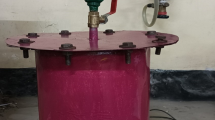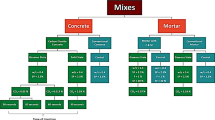Abstract
CO2 sequestration by mineral carbonation in calcium- and magnesium-rich cementitious materials, such as cement-based concrete, during production is a beneficial utilization of CO2. This way, a greenhouse gas is used as an admixture in concrete production, giving double-fold benefits. The present research investigates the properties of concrete produced with CO2 as an admixture. A novel two-step CO2 mineralization into concrete process was adopted in the present research; 0.1%, 0.2% and 0.3% CO2 were mineralized in three batches of concrete and compared with normal concrete, in which no CO2 was mineralized. Slump, compressive strength, flexural strength, changes in compressive strength, weight and chloride ions content under chloride exposure conditions were determined. In addition, scanning electron microscopy was studied to determine the microstructure of concrete. The finding of the present research is quite promising for the use of CO2 by a small percentage of cement used in concrete. At 0.2% CO2 mineralization by the weight of cement used, 6.3% and 3.28% greater compressive and flexural strength, respectively, were noticed at 28 days of testing. Furthermore, a 1.42% higher compressive strength, 0.1% lower rise in weight, and 0.03% lower chloride content were found in CO2 mineralized concrete at 180 days of chloride exposure condition than normal concrete. Hence, this research shows the beneficial use of CO2 as an admixture in concrete is a viable practice for improving concrete properties and reducing CO2 emission into the atmosphere.













Similar content being viewed by others
References
Barcelo L, Kline J, Walenta G, Gartner E (2014) Cement and carbon emissions. Mater Struct Constr 47:1055–1065. https://doi.org/10.1617/s11527-013-0114-5
Priyanka M, Muniraj K, Madduru SRC (2022) Influence of geopolymer aggregates on microstructural and strength characteristics of OPC concrete. Innov Infrastruct Solut. https://doi.org/10.1007/s41062-021-00624-8
Gupta S, Kua HW, Low CY (2018) Use of biochar as carbon sequestering additive in cement mortar. Cem Concr Compos 87:110–129. https://doi.org/10.1016/j.cemconcomp.2017.12.009
Smarzewski PD, Hunek B (2018) Property assessment of hybrid fiber-reinforced ultra-high-performance concrete. Int J Civ Eng 16(6):593–606. https://doi.org/10.1007/s40999-017-0145-3
Pallempati H, Beneberu E, Yazdani N (2016) Evaluation of external FRP-concrete bond in repaired concrete bridge girders and columns. Innov Infrastruct Solut 1(1):1–8. https://doi.org/10.1007/s41062-016-0012-0
Kazmi MA, Prasad MLV (2022) Investigation on mechanical, durability and time-dependent properties of standard grade recycled aggregate concrete with pozzolanic material. Indian J Eng Mater Sci 29(1):62–70. https://doi.org/10.56042/ijems.v29i1.45448
Kumar M, Prashant S, Kamath MV (2022) Enhancing the sustainability of high strength concrete in terms of embodied energy and carbon emission by incorporating sewage sludge and fly ash. Innov Infrastruct Solut. https://doi.org/10.1007/s41062-022-00837-5
Tantri A, Nayak G, Shenoy A, Shetty KK, Achar J, Kamath M (2022) Implementation assessment of calcined and uncalcined cashew nut-shell ash with total recycled concrete aggregate in self-compacting concrete employing Bailey grading technique. Innov Infrastruct Solut. https://doi.org/10.1007/s41062-022-00907-8
Sarıdemir M, Severcan MH, Çiflikli M, Çelikten S (2017) Microstructural analyses of high strength concretes containing metakaolin at high temperatures. Int J Civ Eng 15(2):273–285. https://doi.org/10.1007/s40999-016-0081-7
Wang D, **ao J, Duan Z (2022) Strategies to accelerate CO2 sequestration of cement-based materials and their application prospects. Constr Build Mater 314:125646. https://doi.org/10.1016/j.conbuildmat.2021.125646
Gupta S, Kashani A, Mahmood AH (2022) Carbon sequestration in engineered lightweight foamed mortar – Effect on rheology, mechanical and durability properties. Constr Build Mater 322:126383. https://doi.org/10.1016/j.conbuildmat.2022.126383
Monkman S, Kenward PA, Dipple G, MacDonald M, Raudsepp M (2018) Activation of cement hydration with carbon dioxide. J Sustain Cem Mater 7(3):160–181. https://doi.org/10.1080/21650373.2018.1443854
Monkman S, MacDonald M (2017) On carbon dioxide utilization as a means to improve the sustainability of ready-mixed concrete. J Clean Prod 167:365–375. https://doi.org/10.1016/j.jclepro.2017.08.194
Monkman S, Sargam Y, Naboka O, Lothenbach B (2022) Early age impacts of CO2 activation on the tricalcium silicate and cement systems. J CO2 Util 65:102254. https://doi.org/10.1016/j.jcou.2022.102254
Kou SC, Zhan BJ, Poon CS (2014) Use of a CO2 curing step to improve the properties of concrete prepared with recycled aggregates. Cem Concr Compos 45:22–28. https://doi.org/10.1016/j.cemconcomp.2013.09.008
Monkman S, Shao Y (2006) Assessing the carbonation behavior of cementitious materials. J Mater Civ Eng 18(6):768–776. https://doi.org/10.1061/(asce)0899-1561(2006)18:6(768)
Junior AN, Filho RDT, Fairbairn EDMR, Dweck J (2015) The effects of the early carbonation curing on the mechanical and porosity properties of high initial strength Portland cement pastes. Constr Build Mater 77:448–454. https://doi.org/10.1016/j.conbuildmat.2014.12.072
Monkman S, Lee BEJ, Grandfield K, MacDonald M, Raki L (2020) The impacts of in-situ carbonate seeding on the early hydration of tricalcium silicate. Cem Concr Res 136:106179. https://doi.org/10.1016/j.cemconres.2020.106179
Dixit A, Du H, Pang SD (2021) Carbon capture in ultra-high performance concrete using pressurized CO2 curing. Constr Build Mater 288:123076. https://doi.org/10.1016/j.conbuildmat.2021.123076
Tam VWY, Butera A, Le KN (2020) Microstructure and chemical properties for CO2 concrete. Constr Build Mater 262:120584. https://doi.org/10.1016/j.conbuildmat.2020.120584
Winnefeld F, Leemann A, German A, Lothenbach B (2022) CO2 storage in cement and concrete by mineral carbonation. Curr Opin Green Sustain Chem 38:100672. https://doi.org/10.1016/j.cogsc.2022.100672
Monkman S, MacDonald M (2016) Carbon dioxide upcycling into industrially produced concrete blocks. Constr Build Mater 124:127–132. https://doi.org/10.1016/j.conbuildmat.2016.07.046
Qian X, Wang J, Fang Y, Wang L (2018) Carbon dioxide as an admixture for better performance of OPC-based concrete. J CO2 Util 25:31–38. https://doi.org/10.1016/j.jcou.2018.03.007
IS 269:2015 (2020) Ordinary Portland cement. Bureau of Indian Standards, New Delhi
IS 3812 (Part 1):2013 (2017) Pulverized fuel ash—specification part for use as Pozzolana in cement, cement mortar, and concrete. Bureau of Indian Standards, New Delhi
IS 383: 2016 (2016) Coarse and fine aggregate for concrete—specification. Bureau of Indian Standards, New Delhi
IS 9103:1999 (2018) Concrete admixtures — Specification. Bureau of Indian Standards, New Delhi
IS 456: 2000 (2021) Plain and reinforced concrete—forth revision. Bureau of Indian Standards, New Delhi
IS 10262: 2019 (2019) Concrete mix proportioning—guidelines. Bureau of Indian Standards, New Delhi
IS 1199 (Part-2):2018 (2018) Fresh concrete—methods of sampling, testing and analysis)—determination of consistency of fresh concrete. Bureau of Indian Standards, New Delhi
IS:516 Part-1, Sec-1:2021 (2021) Hardened concrete—methods of test, testing of strength of hardened concrete—compressive, flexural and split tensile strength. Bureau of Indian Standards, New Delhi
ASTM C 267-01 (2001) Standard test methods for chemical resistance of mortars, grouts, and monolithic surfacings and polymer concretes. ASTM International, West Conshohocken, PA, pp 1–6
IS 14959 (Part 2): 2001 (2021) Determination of water-soluble and acid-soluble chlorides in mortar and concrete—method of test the (hardened mortar and concrete). Bureau of Indian Standards, New Delhi
ASTM C1723-10 (2010) Standard guide for examination of hardened concrete using scanning electron microscopy. ASTM International, West Conshohocken, PA, pp 1–17
Mishra G, Warda A, Shah SP (2022) Carbon sequestration in graphene oxide modified cementitious system. J Build Eng. 62:105356. https://doi.org/10.1016/j.jobe.2022.105356
Monkman S, MacDonald M, Hooton D (2016) The durability of concrete produced using CO2 as an admixture. Sustain Constr Mater Technol 74:218–224. https://doi.org/10.18552/2016/scmt4s165
Liyana N, Kamal M, Itam Z, Sivaganese Y, Beddu S (2020) Carbon dioxide sequestration in concrete and its effects on concrete compressive strength. Mater Today Proc 31:A18–A21. https://doi.org/10.1016/j.matpr.2020.11.185
Tam VW, Butera A, Le KN (2021) Mechanical properties of CO2 concrete utilizing practical carbonation variables. J Clean Prod 294:126307. https://doi.org/10.1016/j.jclepro.2021.126307
Wang X, Ni W, Li J, Zhang S, Li K (2021) Study on mineral compositions of direct carbonated steel slag by QXRD, TG, FTIR, and XPS. Energies 14(15):4489. https://doi.org/10.3390/en14154489
Hosan A, Shaikh FUA (2021) Compressive strength development and durability properties of high volume slag and slag-fly ash blended concretes containing nano-CaCO3. J Mater Res Technol 10:1310–1322. https://doi.org/10.1016/j.jmrt.2021.01.001
Chen Y, Gao J, Tang L, Li X (2016) Resistance of concrete against the combined attack of chloride and sulfate under drying-wetting cycles. Constr Build Mater 106:650–658. https://doi.org/10.1016/j.conbuildmat.2015.12.151
Bullard JW, Scherer GW, Thomas JJ (2015) Time dependent driving forces and the kinetics of tricalcium silicate hydration. Cem Concr Res 74:26–34. https://doi.org/10.1016/j.cemconres.2015.03.016
Jeffrey JT, Hamlin MJ (2009) Influence of nucleation seeding on the hydration mechanisms of tricalcium silicate and cement and cement. J Phys Chem 113:4327–4334. https://doi.org/10.1021/jp809811w
Saillio M, Bouny VB, Barberon F (2014) Chloride binding in sound and carbonated cementitious materials with various types of binder. Constr Build Mater 68:82–91. https://doi.org/10.1016/j.conbuildmat.2014.05.049
Helmy SH, Tahwia AM, Mahdy MG, Elrahman MA (2023) Development and characterization of sustainable concrete incorporating a high volume of industrial waste materials. Constr Build Mater 365:130160. https://doi.org/10.1016/j.conbuildmat.2022.130160
Tahwia AM, Abd Ellatief M, Heneigel AM, Abd Elrahman M (2022) Characteristics of eco-friendly ultra-high-performance geopolymer concrete incorporating waste materials. Ceram Int 48(14):19662–19674. https://doi.org/10.1016/j.ceramint.2022.03.103
Han X, Feng J, Shao Y, Hong R (2020) Influence of a steel slag powder-ground fly ash composite supplementary cementitious material on the chloride and sulfate resistance. Powder Technol 370:176–183. https://doi.org/10.1016/j.powtec.2020.05.015
Abdellatief M, Alanazi H, Radwan MKH, Tahwia AM (2022) Multiscale characterization at early ages of ultra-high performance geopolymer concrete. Polymers 14:5504. https://doi.org/10.3390/polym14245504
Dang VQ, Ogawa Y, Bui PT, Kawai K (2021) Effects of chloride ions on the durability and mechanical properties of sea sand concrete incorporating supplementary cementitious materials under an accelerated carbonation condition. Constr Build Mater 274:122016. https://doi.org/10.1016/j.conbuildmat.2020.122016
Florea MVA, Brouwers HJ (2014) Modelling of chloride binding related to hydration products in slag-blended cements. Constr Build Mater 64:421–430. https://doi.org/10.1016/j.conbuildmat.2014.04.038
Tahwia AM, Hamido MA, Elemam WE (2023) Using mixture design method for develo** and optimizing eco-friendly ultra-high performance concrete characteristics. Case Stud Constr Mater 18:e01807. https://doi.org/10.1016/j.cscm.2022.e01807
Gupta N, Kishore K, Saxena KK, Joshi TC (2021) Influence of industrial by-products on the behavior of geopolymer concrete for sustainable development. Indian J Eng Mater Sci 28(5):433–445. https://doi.org/10.56042/ijems.v28i5.45206
Nili M, Afroughsabet V (2012) The long-term compressive strength and durability properties of silica fume fiber-reinforced concrete. Mater Sci Eng A 531:107–111. https://doi.org/10.1016/j.msea.2011.10.042
Alsaadawi MM, Amin M, Tahwia AM (2022) Thermal, mechanical and microstructural properties of sustainable concrete incorporating phase change materials. Constr Build Mater 356:129300. https://doi.org/10.1016/j.conbuildmat.2022.129300
Tahwia AM, Elgendy GM, Amin M (2021) Durability and microstructure of eco-efficient ultra-high-performance concrete. Constr Build Mater 303:124491. https://doi.org/10.1016/j.conbuildmat.2021.124491
Tahwia AM, Heniegal AM, Abdellatief M, Tayeh BA, Elrahman MA (2022) Properties of ultra-high performance geopolymer concrete incorporating recycled waste glass. Case Stud Constr Mater 17:e01393. https://doi.org/10.1016/j.cscm.2022.e01393
Li G, Zhang A, Song Z, Liu S, Zhang J (2018) Ground granulated blast furnace slag effect on the durability of ternary cementitious system exposed to combined attack of chloride and sulfate. Constr Build Mater 158:640–648. https://doi.org/10.1016/j.conbuildmat.2017.10.062
Francioso V, Moro C, Martinez-Lage I, Velay-Lizancos M (2019) Curing temperature: A key factor that changes the effect of TiO2 nanoparticles on mechanical properties, calcium hydroxide formation and pore structure of cement mortars. Cem Concr Compos 104:103374. https://doi.org/10.1016/j.cemconcomp.2019.103374
Author information
Authors and Affiliations
Contributions
MAK contributed to investigation, conducting tests, development of mixtures, researching articles, visualization, conceptualization, original manuscript, and final editing. MLVP contributed to supervision, methodology, and final editing.
Corresponding author
Ethics declarations
Conflict of interest
The authors declare that they have no conflict of interest.
Ethical approval
Authors declare that this research article is an original report of our research and has been written by the authors of the present article; work described in this article has not been published before, and that it is not under consideration for publication anywhere else. The experimental work is entirely the authors' work; the entire work has been carried out at the affiliating institution of the authors, and the publisher will not be held legally responsible should there be any compensation claims. Also, its publication has been approved by all authors.
Rights and permissions
Springer Nature or its licensor (e.g. a society or other partner) holds exclusive rights to this article under a publishing agreement with the author(s) or other rightsholder(s); author self-archiving of the accepted manuscript version of this article is solely governed by the terms of such publishing agreement and applicable law.
About this article
Cite this article
Kazmi, M.A., Prasad, M.L.V. Experimental study on the potential use of CO2 as an admixture in concrete. Innov. Infrastruct. Solut. 8, 95 (2023). https://doi.org/10.1007/s41062-023-01062-4
Received:
Accepted:
Published:
DOI: https://doi.org/10.1007/s41062-023-01062-4




